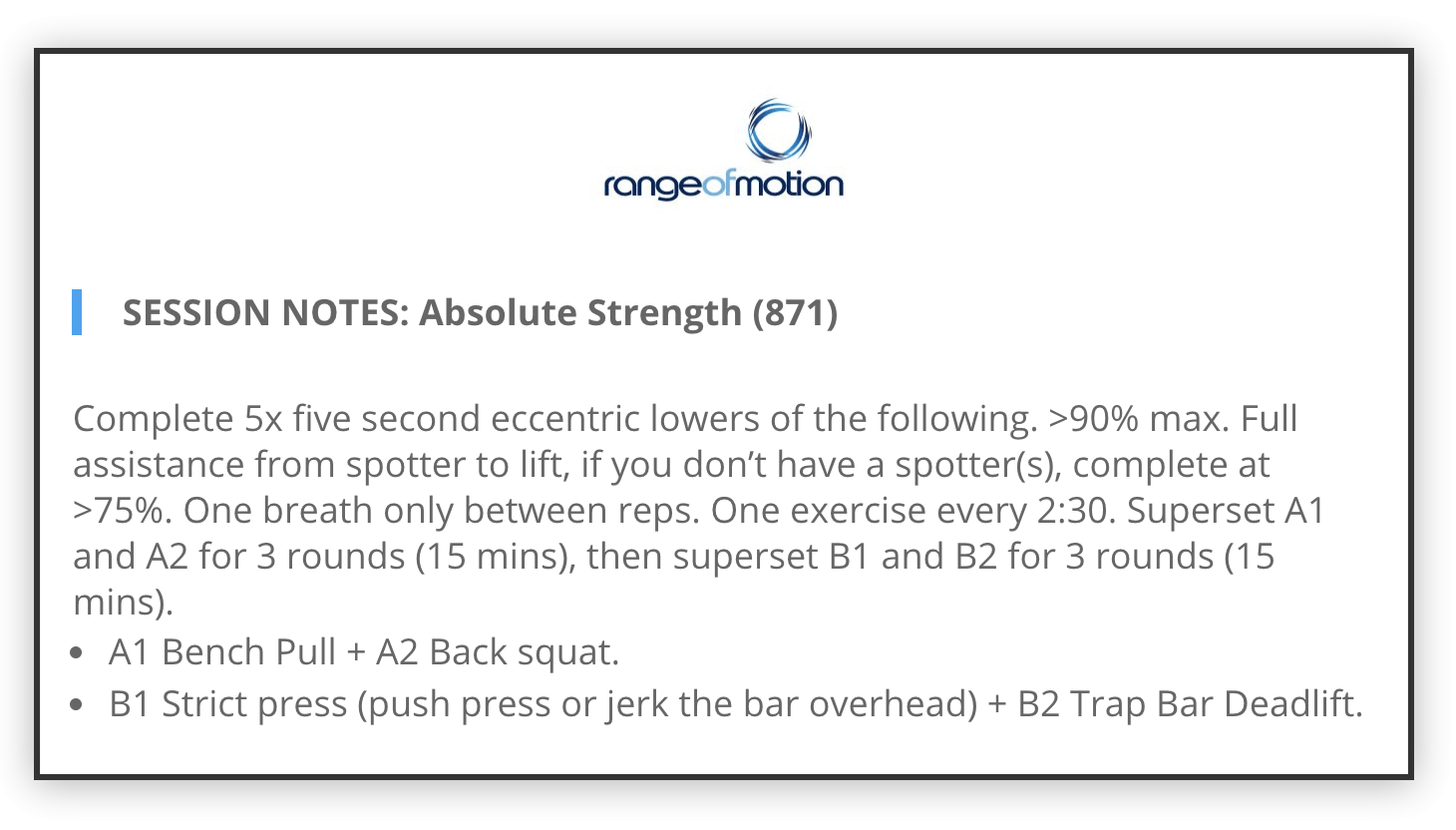
SESSION NOTES: Absolute Strength (871)
Complete 5x five second eccentric lowers of the following. >90% max. Full assistance from spotter to lift, if you don’t have a spotter(s), complete at >75%. One breath only between reps. One exercise every 2:30. Superset A1 and A2 for 3 rounds (15 mins), then superset B1 and B2 for 3 rounds (15 mins).
- A1 Bench Pull + A2 Back squat.
- B1 Strict press (push press or jerk the bar overhead) + B2 Trap Bar Deadlift.
Programming Science:
This session takes advantage of the benefits of eccentric training. ‘Eccentric’ refers to the type of contraction your muscle does as it is lengthening – yielding to gravity.
If completed on your own, we refer to this as ‘eccentric tempo training’. If complete with partner(s) spotting you (highly preferred), it’s ‘accentuated eccentric training’ – a form of eccentric training where the load lowered is more than the load lifted. This adds positive stress on the body in the phase of the lift that will give us the most benefit.
Accentuated Eccentric Loading delivers superior results to strength, power and hypertrophy (muscle size) over any other eccentric training method studied.
We use these techniques for four movements – a squat based movement, a deadlift based movement, an upper body press based movement and an upper body pull based movement.
The exercises are in two pairs, with very low interference between those two movements. The exercises alternate to allow you to rest as much as possible between each set of the same type of exercise, while still being mindful of time efficiency. This is then repeated for the second pair of exercises.
Health and Body Composition Benefits:
Eccentric training has wide reaching benefits to your health and body composition – with the benefits even broader than standard resistance training.
Eccentric training results in stronger connective tissue (ligaments and tendons) and increased flexibility by changing the mechanics of a muscle (increasing the sarcomeres in series).
These changes in the mechanics and organisation of muscle fibres, also mean eccentric training is a great rehabilitation tool – not only to help promote the repair and recovery of soft tissue (particularly tendon) injury, but also to reduce the risk of future injury.
Resistance training (using your muscles to lift heavy weights, either external weights or yourself) makes you stronger. Strength is one of the greatest predictors of both your lifespan (how long you live) and your healthspan (how long you live in a healthy state).
Resistance training like this will also improve your flexibility (by going through a full range of motion), posture and coordination. It will also build stability around your joints and spine to give you a healthy musculo-skeletal system and reduce joint and back pain.
The session will minimise losses in bone mineral density and will improve your balance. Strength and balance are the two strongest predictors of falls later in life, so this is an effective way to train fall prevention, and insure your independence into old age.
As a result of this style of session, you will experience changes in blood chemistry, including favourable effects on cholesterol, blood glucose, triglyceride and lipid levels.
This session increases your lean muscle mass and muscle fibre size. The increased muscle damage (which is a positive) from eccentric training will create a greater muscle-building response that standard resistance training. Muscle is a metabolically active tissue, so increasing it will maximise how much energy your body burns at rest. This makes it an effective session to reach healthy levels of body fat, both visceral fat (around the organs) and subcutaneous fat (under your skin).
After this session, your body will go through a prolonged state of ‘EPOC’ (excess post- exercise oxygen consumption), meaning you’ll continue burning energy long after you finish training – further aiding healthy body composition.Eccentric training, in particular, causes these favourable changes to your resting metabolic rate.
Performance Benefits:
The heavy levels of resistance in this session are designed to increase your strength – increasing both your one rep max, and your ability to lift submaximal weights. By being stronger, you can lift more weight, and you will be able to lift submaximal weights faster and for higher reps because they’ll be at a lower percentage of your max.
The research is virtually unanimous in heaping praise on ‘eccentric’ training (sometimes called ‘negatives’). This style of training shows strength gains in excess of 10% over traditional methods, and results in great hypertrophy (muscle growth).
Not only is eccentric training superior to regular strength training, but the use of accentuated eccentric loading delivers superior results to strength, power and hypertrophy (muscle size) over any other eccentric training method studied.
Not only are we able to generate more force after eccentric training, but we are also able to generate it over a greater variance in muscle lengths. Effectively, what this does is to make us stronger over a greater range of motion, increasing our muscles’ torque generating ability. Therefore, less sticking points, less failures on heavy lifts.
This session will also improve the efficiency of your fast-twitch muscle fibres (those responsible for lifting heavy and fast), and will improve your neuromuscular efficiency (your ability to turn on a very high percentage of your muscle fibres).
Strategy:
Put a priority on completing this session with full partner spotting. This will allow you to maximise the weight, and therefore the benefits of the session.
As the contraction is eccentric, you will be able to lift (lower) more weight than you expect.
Work hard to maintain positions and tension throughout the entire range.
How it Should Feel:
This session should feel very heavy – particularly as you’ll be lowering a weight that is far in excess of what you’d normally lift. It should feel like you’re having to fight gravity to control the speed of descent and maintain the five second lower.
Scaling Guidelines:
The preference with scaling for this is to keep the range of motion and reduce weight. Modify around injuries with exercises as close as possible to the stimulus of the movement you’re modifying.
Common Mistakes:
Choosing to do this session without a spotter. While this will still give benefit, it won’t give nearly the benefit of full assistance on the concentric (lifting) portion of the lift.
Modifying the speed of movement is a technique used to help make the eccentric portion more difficult (and therefore more beneficial). However, the slow eccentric contraction is followed by a tough, grindy concentric lift. Even though we’re using a slow ‘tempo’ to try to overload the eccentric (lowering) phase, the concentric (lifting) phase is almost always the limiting factor, and is almost always the first thing to fail. And so, we know we’re not overloading the eccentric phase as much as we could, because it’s limited by another part of the lift.
Using a spotter(s) is the best solution to this problem.
The second common mistake here is to count the five second count without the use of a clock. A timer should be used to ensure the slow eccentric contraction is adhered to.
Finally, when completing this session with assistance from a spotter, you will be able to go heavier than you might expect – due to the superior strength during an eccentric contraction.





